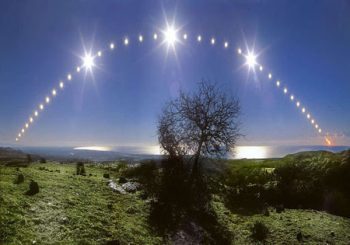By Nikki Harper
Staff Writer for Wake Up World
You’re probably aware that we’re approaching a very special event. June 20th sees the summer solstice in the northern hemisphere, and the winter solstice in the southern hemisphere. Just hours after the solstice, a spectacular and astrologically important solar eclipse also occurs – and this combination of astrological energies and solstice symbology is a potent opportunity for spiritual growth for us all.
[pro_ad_display_adzone id=”110028″]
What is the Solstice?
Every year, we have two solstices. These are the moments when the Sun reaches its highest point in its daily path across the sky (as we see it), or its lowest, depending where on earth you are. The June solstice is the summer solstice for the northern hemisphere, but it’s the winter solstice for the southern hemisphere. Likewise, the December solstice is the winter solstice for the northern hemisphere, but the summer solstice for the southern.
During a summer solstice, we receive the maximum hours of daylight for that year – that’s why we call it the longest day and the shortest night. A winter solstice gives us the shortest daylight hours and the longest night of the year.
So, on June 20th in the northern hemisphere, we will see our longest day of the year – and thereafter, the days will start to shorten. The September equinox will see roughly equal hours of daylight and night. Then the December solstice brings us our shortest day, and we see the days start to lengthen again until the equal point of the March equinox. In the southern hemisphere, this cycle is reversed.
What’s Special About this Eclipse?
Just hours after the exact moment of the June solstice this year, there will be an annular solar eclipse – a so-called ‘ring of fire’ eclipse, which is almost as spectacular to view as a total solar eclipse. It’s not visible from everywhere in the world, but will be visible from parts of Africa, the Middle East, India and China.
Astrologically, this eclipse is important because of the cardinal grand cross it creates, giving us an opportunity to create change in a troubled world. It has potent geopolitical implications and will be important to you on a personal level too if you have significant planets in the first five degrees of Aries, Cancer, Libra or Capricorn.
How Rare is the Solstice Eclipse?
On average, we would expect to see a solstice solar eclipse like this once every 80 or so years. However, because of the Metonic cycle, we sometimes get clusters of eclipses repeating on a 19 year cycle, and we’re currently experiencing this. The last solstice eclipse was 19 years ago and preceded the world-changing events of 9/11. There was also one 19 years before that, in 1982, and we will experience solstice eclipses in 2039 and 2058 too – but after that, it will be almost 200 years before another one occurs.
What Does the Summer Solstice Eclipse Have to Teach Us?
The spiritual symbology of the summer solstice is about light – not surprisingly, but it’s also about patience and about nurturing. The summer solstice does after all mark the arrival of the Sun in astrological Cancer, that most nurturing of signs.
At this moment of maximum sunlight in the northern hemisphere, we have to wait for our crops to ripen. We know something good is coming, but it’s not here yet. We must continue to take care of the things which are currently ripening, before we can reap the rewards.
This point of maximum sunlight also encourages us to find ways to express our own divine light. It’s a creative moment, a time for letting your light shine as brightly as it possibly can.
From this point on, in the annual calendar, we know that darkness is coming. There won’t be as much daylight again this calendar year. So, there’s also a sense of urgency, even while we try to be patient. Motivation is often at an all time high, but it can be difficult not to act in haste. The Cancer solar eclipse is cardinal, but we must learn not to run before we can walk. Because it’s an annular solar eclipse, those lucky enough to see it will see a ring of fire. Spiritually and astrologically, we see fire as a creative force, but it would pay us to remember that fire can destroy too.
What Does the Winter Solstice Eclipse Have to Teach Us?
If you’re in the southern hemisphere, the winter solstice in June is a point of celebration. It marks the shortest night – from here, days begin to lengthen, and light and warmth will return. The worst is over. It’s time to make plans and set intentions for the year ahead.
The symbology of the winter solstice is also about regeneration. Usually, the coldest winter weather is yet to come, but we know that beneath the frozen ground, seeds are safely biding their time, ready to burst into life.
So, the winter solstice teaches us that no matter how dark life gets, light will always return. And that while it’s dark, we can go within for comfort, reflecting and growing ourselves. The Cancer solar eclipse, meanwhile, encourages you to be kind to yourself while the darkness fades. The ring of fire from the annual eclipse symbolizes the life which will shortly return to your land.
Even though the solstice (whether it’s winter or summer for you) is just one moment in time, and even though the annular eclipse takes just a couple of hours to complete, we can honour the energies of the solstice and the eclipse throughout the 24 hours or so following these events.
Suggestions for Honouring the Summer Solstice
The single best way to honour the energies of the summer solstice is to get outdoors and to feel the sun – no matter what the weather is like. Make a point of feeling the sun on your skin; if it’s overcast or raining, wait for a break in the clouds. Remember, sunlight is filtering through during daylight hours even if you can’t see the sun – if it wasn’t, it would be dark.
Get creative on the theme of the sun and light – this is the perfect excuse for some large-scale artwork in the yard, or for letting your inner kid run riot with the paintbox.
Find a way to express your divine light by helping others, being a source of support, passing on joy or being a friend to someone in need.
Practice patience by setting out a step by step route map towards a cherished goal, understanding that you cannot get there all at once.
Nurture someone – your family, your loved ones, your pets, your plants. Nurture at a distance if you have to, by sending someone a loving message or by donating to an animal shelter, but nurture as if your life depended up on it. In some ways, it does.
Suggestions for Honouring the Winter Solstice
Wait for the sun to go down, turn off all of the lights and sit in the darkness. If you are or can go somewhere with dark skies, so much the better. Embrace all you can of the darkness, because from this point it will start to fade, and you will miss its embrace.
When you have drunk your fill of the darkness, light candles to signify the return of the light. Repeat affirmations as you do so or say a personal prayer.
If it’s safe to do so, set up a fire, in a fireplace or somewhere responsible outdoors. The winter solstice is a great time to commit to letting go of bad habits and negative behaviour patterns – so write down some personal habits or behaviours you would like to be free from. Write them on small pieces of paper and put them one at a time in the fire, committing yourself to positive action as you watch them burn.
Renew your vows to your life partner – or make some. Or renew your promise to someone. You’ve come through the worst, symbolically, so now is a good time to re-affirm the commitments you have chosen to make to another human.
However you choose to mark the solstice, and whether it’s winter or summer where you are, reflecting on the symbology of the solstice can bring insight into your life’s journey through the year. Blend this with and understanding of the astrology behind this year’s solstice eclipse, and you should benefit from a new awareness. Have a blessed solstice!
Recommended articles by Nikki Harper:
- Harnessing the Power of Synchronicity
- Beyond 11:11 – The Significance of Repeating Number Patterns
- A Time to be Born and a Time to Die: Can Astrology Predict Death?
- Premature and Caesarean Birth: An Astrological Misinheritance?
- The Benefits of a Daily Divination Practice – and How to Start One
- 7 Ways to Find Awe in Your Everyday Life
- Need Answers? Looking for Insight? 7 Ways Astrology Can Help
- Alone But Not Lonely: 6 Amazing Benefits of Solitude
- Dancing in the Rain: 6 Reasons We Should All Be Pluviophiles
- Finding Time for a Daily Spiritual Practice – How and Why to Devote Your Time
- 7 Simple Steps to Start Communicating With Nature
- Getting Started with Remote Viewing: Step by Step to Strengthen Your Psi Abilities
About the author:
 Nikki Harper is a spiritualist writer, astrologer, and editor for Wake Up World. She writes about divination, astrology, mediumship and spirituality at Questionology: Astrology and Divination For the Modern World where you can also find out more about her work as a freelance astrologer and her mind-body-spirit writing and editing services. Nikki also runs a spiritualist centre in North Lincs, UK, hosting weekly mediumship demonstrations and a wide range of spiritual development courses and workshops.
Nikki Harper is a spiritualist writer, astrologer, and editor for Wake Up World. She writes about divination, astrology, mediumship and spirituality at Questionology: Astrology and Divination For the Modern World where you can also find out more about her work as a freelance astrologer and her mind-body-spirit writing and editing services. Nikki also runs a spiritualist centre in North Lincs, UK, hosting weekly mediumship demonstrations and a wide range of spiritual development courses and workshops.
Say hi at Questionology.co.uk or on Facebook.
[pro_ad_display_adzone id=”110027]





